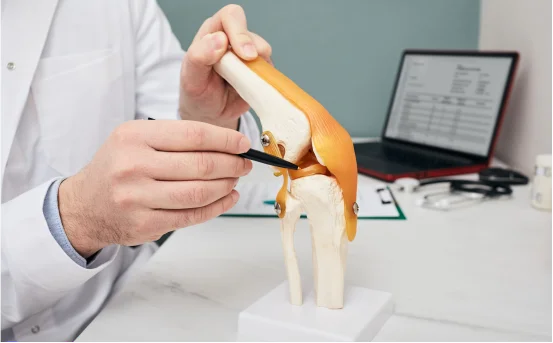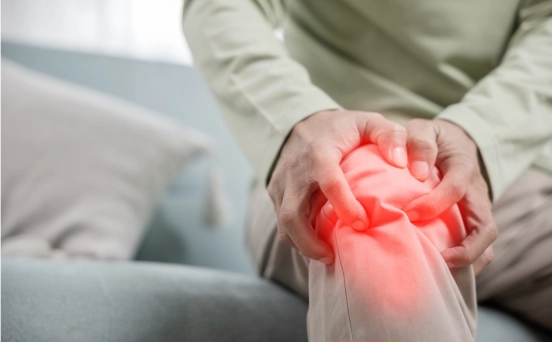Knee pain is a common issue that affects people of all ages whether you’re an athlete, a working professional, or simply dealing with wear and tear over time. When non-surgical treatments like medication, physiotherapy, or injections don’t offer enough relief, doctors often recommend a minimally invasive option known as knee arthroscopy surgery.
Knee arthroscopy allows surgeons to look inside the knee joint using a small camera, identify the exact problem, and fix it often in the same procedure. But what exactly leads someone to need this kind of surgery? Let’s explore the most common causes that make knee arthroscopy necessary.
Causes of Knee Arthroscopy Surgery
- Meniscus Tears :- Among the top reasons people undergo knee arthroscopy is a meniscus tear. The meniscus is a rubbery, C-shaped cartilage that acts as a shock absorber between the thigh bone (femur) and shin bone (tibia). Meniscus tears often occur during sports activities that involve twisting, turning, or sudden stops common in football, basketball, and tennis. However, they can also happen from simple actions like squatting or stepping the wrong way.
As we age, the meniscus becomes more fragile and easier to tear, even without injury. People with torn menisci may experience pain, swelling, difficulty moving the knee, or a sensation that the knee is locking or catching. When these symptoms don’t improve with rest or therapy, arthroscopy becomes an ideal option to either repair or trim the damaged portion, relieving pain and restoring function.
- Ligament Injuries, Especially ACL Tears :- Injuries to the ligaments of the knee, especially the anterior cruciate ligament (ACL), are another major reason for arthroscopic surgery. The ACL is a critical stabilizer of the knee joint and is often injured during high-impact sports or sudden movements, such as pivoting or awkward landings. Athletes are particularly prone to this kind of injury, but it can also happen in everyday life during falls or accidents.
ACL injuries often lead to instability in the knee, making it hard to walk, run, or change direction comfortably. In younger or active patients, especially athletes, arthroscopic ACL reconstruction is commonly performed to restore knee stability and allow a return to normal activity. The same applies to other ligaments like the posterior cruciate ligament (PCL) or medial collateral ligament (MCL) when damaged.
- Loose Bodies Inside the Knee Joint :- Over time or due to injury, fragments of bone or cartilage may break loose and float around inside the joint. These are known as loose bodies. Although they’re small, these fragments can cause big problems. They may get trapped between the moving parts of the knee, leading to intermittent pain, sudden locking, swelling, or a grinding sensation when moving the leg.
Knee arthroscopy is a highly effective way to locate and remove loose bodies without resorting to open surgery. Patients often report immediate relief from discomfort and a noticeable improvement in joint movement once these fragments are removed.
- Cartilage Wear or Damage :- Cartilage is the smooth, slippery tissue that covers the ends of bones in the knee, allowing them to glide easily during movement. When cartilage gets damaged due to injury, overuse, or age-related degeneration, it can lead to pain, stiffness, and even early arthritis. In some cases, small areas of cartilage may wear away or crack, leading to swelling and discomfort with regular movement.
During arthroscopy, the surgeon can clean up the damaged cartilage, smooth rough surfaces, or stimulate new cartilage growth through techniques like microfracture. Addressing cartilage damage early through arthroscopy can help delay the onset of more severe joint problems and extend the life of the natural knee.
- Synovitis: Inflammation of the Knee Lining :- The knee joint is lined with a thin membrane called the synovium, which produces fluid to lubricate the joint. In some cases, this lining becomes inflamed a condition known as synovitis. Synovitis can be triggered by repetitive motion injuries, overuse, or autoimmune diseases like rheumatoid arthritis.
When medications and other conservative treatments fail to control the inflammation, arthroscopic surgery may be used to remove the inflamed synovial tissue. This can help reduce pain and swelling and prevent further joint damage, especially in chronic cases.
- Knee Infections (Septic Arthritis) :- Although relatively rare, knee infections inside the joint medically known as septic arthritis can be extremely serious and require urgent surgical treatment. Infections may occur following injury, surgery, or in people with weakened immune systems. Symptoms include severe pain, swelling, redness, and fever.
Knee arthroscopy allows surgeons to thoroughly wash out the infected area, drain pus or fluid buildup, and clean the joint. This is often combined with antibiotics to eliminate the infection. Prompt arthroscopic treatment helps save the joint and prevents complications that could lead to permanent damage or even the need for joint replacement.
- Unexplained, Persistent Knee Pain :- Sometimes, patients experience knee pain that doesn’t improve with rest, medication, or therapy and imaging tests don’t clearly explain what’s wrong. In these cases, arthroscopy serves as both a diagnostic and therapeutic tool. The surgeon can directly visualize the inside of the joint, identify issues that may not show up on an MRI or X-ray (like soft tissue injuries or early cartilage damage), and often fix the problem during the same procedure.
Conclusion
Knee arthroscopy is more than just a procedure it’s a pathway to relief, mobility, and a better quality of life for those dealing with chronic knee issues or sports-related injuries. Whether it’s a torn meniscus, ligament injury, loose fragments, or ongoing inflammation, this minimally invasive surgery offers a safe and effective solution to restore normal function.
If you’ve been struggling with knee pain that doesn’t seem to go away despite trying everything else, it may be time to explore arthroscopy as an option. Always consult an experienced orthopedic surgeon to evaluate your specific condition and guide you toward the best possible treatment plan.























